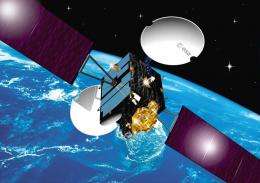Artemis keeps talking the talk

(Phys.org) -- Although ESA’s Artemis telecommunications satellite has officially completed its mission, it still has plenty to offer. Reaching its working orbit almost 11 years ago after an arduous journey, Artemis continues to communicate with Earth.
After almost 11 years in orbit, it is a fact that the Artemis mission has been successfully completed. To meet the demand of its operational users, ESA decided to keep operating Artemis for a few more years until its planned deorbiting in 2014.
Equipped with a suite of advanced communication payloads, Artemis has scored a long series of satcom firsts still in use today and precursors to new ESA programs like the European Data Relay System.
“Artemis has demonstrated technologies that have become standard for many satcom missions and, at the same time, has provided communication services that have exceeded the initial design goals,” said Magali Vaissiere, Director of ESA’s Telecommunications and Integrated Applications.
For example, Artemis created the first laser data link between satellites in different orbits. It was the first telecom satellite to be extensively reprogrammed in orbit, and it was the first to power its way to geostationary orbit, 36 000 km up, with ion thrusters after surviving the longest-ever drift to its destination.
Artemis also provided data relay for Envisat, the largest Earth observation satellite ever built.

Today, Artemis provides links for all of ESA’s Automated Transfer Vehicle (ATV) missions to the International Space Station, from launcher separation to docking, deorbiting and, finally, reentry.
Its navigation payload is a critical element for the European Geostationary Overlay System (EGNOS), which enhances navigation services data for aircraft and ships.
Artemis has been broadcasting the EGNOS signals since 2003 and supports the EGNOS open service and the safety-of-life service.
“Artemis has provided a fundamental contribution to the success of the Envisat, ATV and EGNOS missions, realising an unprecedented level of synergy among many ESA programs,” said Mr. Dordain.
“I wish to thank the project teams in ESA and within industry for their contributions that is opening new doors for satcom services in the field of data relay and enhancing the effectiveness of future European programs.”
Artemis’ list of accomplishments includes establishing two-way links in 2006 and 2007 with an aircraft flying over the southern coast of France, receiving video footage at 50 Mbits per second.
Artemis also provided a two-way link with an unmanned drone dropped from an altitude of 21 km off the coast of Sardinia in 2007. Telemetry and commands were exchanged while the drone was flying in excess of Mach 1.
“Since joining the Artemis adventure, I have discovered a team of people working with passion for the success of this mission,” said Daniele Galardini, Head of Redu Centre and the Artemis project manager. “Thanks to all, it is an honour to work with them.”
Provided by European Space Agency


















